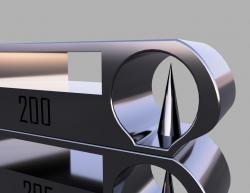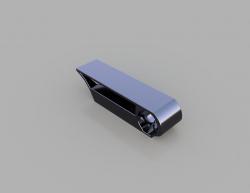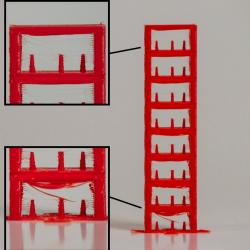 Temperature tower 3D Printer
Temperature tower 3D Printer Temperature tower block 3D Printer, for testing the temperature effects
Temperature tower block 3D Printer, for testing the temperature effects Temperature Tower
Temperature Tower Temperature Tower
Temperature Tower Temperature Tower
Temperature Tower Temperature Tower
Temperature TowerUnderstanding Temperature Towers
A temperature tower is a layered structure printed with incremental changes in temperature at each level. By examining the qualities of each layer, you can determine the best temperature setting for a specific filament. This is particularly useful when experimenting with new materials or striving to achieve the highest quality prints.
Importance in 3D Printing
The importance of temperature towers in 3D printing lies in their ability to fine-tune settings for optimal results. Different filaments, such as PLA, ABS, or PETG, have unique properties and perform best at specific temperatures. Using a temperature tower helps identify the precise temperature at which a filament produces the best results in terms of strength, aesthetics, and overall print quality.
How to Create and Use a Temperature Tower
Creating and using a temperature tower involves several steps:
- Selecting or Designing a Model: You can find temperature tower models on websites like Thingiverse or design your own using 3D software like TinkerCAD for more customizability.
- Setting Up in Slicing Software: Programs like Cura offer plugins for generating temperature towers. Adjust settings such as print temperature, speed, infill, and layer height according to the filament you are using.
- Printing and Analyzing the Tower: After printing the tower, analyze each section to determine which temperature yields the best print quality. Look for factors like layer adhesion, surface finish, and structural integrity.
- Adjusting Your Settings: Based on your analysis, adjust the temperature settings on your printer for future prints with that specific filament.
Tips for Successful 3D Printing with Temperature Towers
- Experiment with Different Filaments: Each filament type may require different temperature settings. Don’t hesitate to experiment with various materials.
- Pay Attention to Layer Adhesion: Apart from the visual inspection of the tower, it’s crucial to check for layer adhesion to ensure the structural integrity of your prints.
- Document Your Findings: Keeping a record of temperature settings for different filaments can save time and improve future print quality.
Q&A
What is the ideal layer height for temperature towers?
For most printers, like the Ender 3, a layer height of 0.2 mm is recommended. This is generally half the diameter of the standard nozzle size.
Can I design my own temperature tower?
Absolutely! If you are comfortable with 3D software, designing your own temperature tower allows for customization according to your specific needs and preferences.
How do I adjust Cura settings for temperature towers?
In Cura, navigate to the “Extensions” menu, select “Post Processing”, and then “Modify G-code”. Use the “ChangeAtZ” script to set up temperature changes at specific heights or layer numbers.
Is a temperature tower necessary for every new filament?
While not mandatory, it’s highly recommended when using a new filament type or brand to ensure optimal print quality and to understand the material’s characteristics.
In summary, temperature towers are a valuable asset in the 3D printing process, offering insights into the ideal printing conditions for various filaments. By carefully designing, printing, and analyzing these towers, you can significantly enhance the quality and reliability of your 3D prints. Remember, the key to successful 3D printing lies in meticulous experimentation and adjustment.
For more detailed information, you can explore the resources provided by All3DP, 3D Printerly, 3DMaker Engineering, and 3DprintingGeek.
